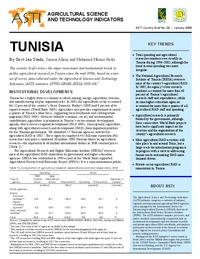Authors:
Stads, Gert-Jan; Allani, Samira; Hedri, Mohamed Mounir
Year:
2006
Publisher
International Food Policy Research Institute (IFPRI); and National Agricultural Research Institute of Tunisia (IRESA)
Back to:
Tunisia’s agricultural research system underwent important reforms over the past decade, facilitated by the national government’s commitment to the agricultural sector and important World Bank-support agricultural research and extension projects. After a period of stagnation due to a recruitment freeze, total agricultural researcher numbers steadily increased from 1996 until 2002. Expenditures in agricultural research evolved more irregularly—hitting a slump in 1998— due to fluctuations in government and donor funding and particularly the completion of the first World Bank-supported project in 1997. Expenditures rebounded to $68 million by 2002
(in 2000 constant prices) with additional government funding focusing on regional development in particular.
Agricultural research in Tunisia is largely funded by the national government. In addition, the World Bank has provided loans for three consecutive projects, the first beginning in 1990 and the most recent scheduled to run until at least 2006. IRESA, the agency that oversees the majority of the country’s agricultural research, was established under the first project. Regional branches were also established to coordinate and evaluate regional agricultural research and extension in support of farmer needs. Subsequent projects have continued to focus on developing regional capacity by building linkages with producers and meeting farmer needs for information, extension, and training. Competitive funding mechanisms for specific project have recently been introduced, though it is too soon as yet to report on their effects.
Overall Tunisia has outperformed its Maghreb counterpart, Morocco, and many Sub-Saharan African countries in several key indicators in recent years. These include total agricultural spending as a share of agricultural output, shares of female researchers, and shares of postgraduate-qualified researchers.

